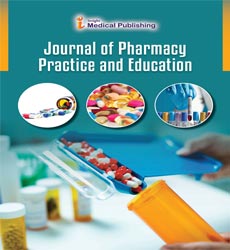Margin of Safety is Desirable, But When Treating a Dangerous Condition or When There are No Other Options
Kevin L*
Department of Pharmacy, University of Tasmania, Tasmania, Australia
- *Corresponding Author:
- Kevin L
Department of Pharmacy
University of Tasmania
Tasmania, Australia
E-mail: kevinl561@partners.org
Received Date: March 05, 2021; Accepted Date: March 22, 2021; Published Date: March 29, 2021
Citation: Kevin L (2021) Margin of Safety is Desirable, But When Treating a Dangerous Condition or When There are No Other Options. J Pharma Prac Edu Vol.4 No.2:e044.
Description
Drug safety (also referred to as pharmacovigilance), is that the science of detection, assessment, understanding and prevention of side effects which allows us to know more about the risks and benefits of a drugs. Historically, new medicines are made of compounds found in plants, fungi and marine organisms. The molecule answerable for the medicinal properties is then extracted, identified and synthesised. Often many similar molecules are made chemically, these are called analogues. These analogues try and improve on the initial compound to maximise desired effects and minimise unwanted effects. Now, new medicines may be made using computer aided design supported knowledge from genomics (the study of genes) and proteomics (the study of proteins).
A vital a part of medicines development, particularly preclinical safety research, involves the employment of animals. Indeed, UK and European regulations currently require that every one new medicine are tested on animals before getting used in humans, to make sure patient safety. The skill of transferring research effectively from preclinical models to early clinical research in man is understood as translational medicine. It also works two ways, by applying what's learnt in clinical practice to see clinical models. We’ve worked closely with NIHR within the establishment of the primary Translational Research Partnerships (TRPs). These unique partnerships pass by the NIHR Office for Clinical Research Infrastructure; facilitate collaborations between industry and academia to drive translational research. There are currently two TRPs in operation: one focussing on inflammatory disease, the opposite on joint and related inflammatory diseases. We and our member companies still work closely with the TRPs to confirm they're aligned with industry, helping to translate early research to safe and effective medicines as quickly as possible.
Before a replacement medicine will be given to humans within the UK, a trial application (CTA) must be approved by bureau of the Department of Health called the Medicines and Healthcare products administrative unit (MHRA). The applying is reviewed by independent medical and scientific experts, who recommend whether trials can begin in humans or whether more research is required first. Abnormal drug metabolism is also thanks to inherited factors of either phase I oxidation or clinical trial conjugation. Pharmacogenomics is that the study of the inherited basis for abnormal drug reactions. Patients have abnormal metabolism by cytochrome P450 because of either inheriting abnormal alleles or because of drug interactions. Tables are available to test for drug interactions because of P450 interactions.
Assigning causality to a particular agent often proves difficult, unless the event is found during a clinical study or large databases are used. Both methods have difficulties and might be fraught with error. Even in clinical studies some ADRs could also be missed as large numbers of test individuals are required to search out that adverse drug reaction. Psychiatric ADRs are often missed as they're grouped together within the questionnaires accustomed assess the population. Many countries have official bodies that monitor drug safety and reactions.
Open Access Journals
- Aquaculture & Veterinary Science
- Chemistry & Chemical Sciences
- Clinical Sciences
- Engineering
- General Science
- Genetics & Molecular Biology
- Health Care & Nursing
- Immunology & Microbiology
- Materials Science
- Mathematics & Physics
- Medical Sciences
- Neurology & Psychiatry
- Oncology & Cancer Science
- Pharmaceutical Sciences
